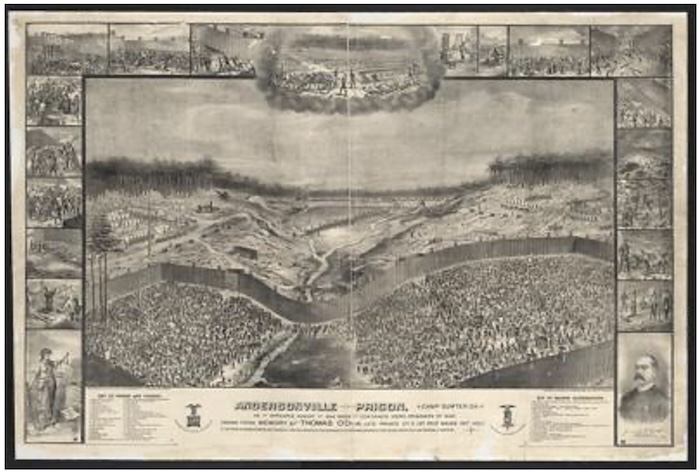Several Union soldiers from Orleans were held (and died) at notorious Andersonville Prison
By Catherine Cooper, Orleans County Historian
“Illuminating Orleans” – Volume 4, No. 16
To this day, a reference to the Civil War Confederate Prison at Andersonville, is synonymous with overcrowding, starvation, suffering and wanton cruelty.
Originally intended to house 10,000 people, some 35,000 prisoners were packed in the site. In its fifteen months of operation, 29% of those interned there died while survivors suffered from years of ill health due to the conditions they endured. Prison commander, Captain Henry Wirz, was the only Confederate soldier executed for war crimes at the end of the War.
The Historical Album of Orleans County (1879) noted that the following Orleans County soldiers were held there:
Carlton
Anderson, George W. sgt. – (Discharged)
Hall, John Bentley, corp. 27th inf., Co. K – (4 months, discharged)
McCarthy, John E., pr. Co. 6, ind. Sharpshooters – (7 months, discharged)
Macomber, Otis, pr. 76th inf., Co. B – (1 year, discharged)
Parkinson, Alfred H., 4th art. – (Died)
Reid, Ambrosall, pr. 76th inf. Co. B – (1 year, discharged)
Willett, Frank E., pr. 8th cav., Co. A – (10 months, discharged)
Gaines
Doyle, Hugh Sgt., 114th inf., Co. B – (Died)
Kendall
Cowell, Charles Jr. Pr. 8th art. Co. K – (Died)
Murray
Flanders, O’Neil, pr. 22nd cav., Co. F – (Died)
Ridgeway
Burch, Philo, pr. 8th cav. – (1 year, discharged)
Hawkins, Isaac, pr. 54th cav. – (Discharged)
Shelby
Ross, Jacob, pr. 151st reg., Co. A – (Died)
Yates
Coleman, James K., Sgt., 3rd Cav., Co. C – (Discharged)
A remarkable depiction of conditions at Andersonville as they appeared on August 1, 1864, was created from memory some years later by Thomas O’Dea. An Irish immigrant, O’Dea enlisted in the 16th Maine Regiment in 1863 at the age of 15. Captured in May 1864, he was sent to Andersonville Prison where he spent nine months.
The scenes depicted by O’Dea teem with detail. Measuring 40×60 in., it is an imposing piece. It takes a few moments to adjust one’s perspective, to focus closely on the center panel where tiny stick figures are crowded in an area bounded by a tall fence.
“The scene of indescribable confusion among the prisoners presents them in every imaginable position, standing, walking, running, arguing, gambling, going to or coming from the Branch with cups, dippers, canteens, or rude pails with water, lying down, dying, praying, giving water or food to the sick, crawling on hands and knees, or hunkers, making fires and cooking rations, splitting pieces of wood almost as fine as matches, the sick being assisted by friends, others “skirmishing for graybacks”, washing clothes and bodies in the Branch, trading in dead bodies, fighting, snaring, shouting …”. Excerpt from History of O’Dea’s Famous Picture of Andersonville Prison by Thomas O’Dea, 1887
Smaller vignettes along the top and sides depict equally grim scenes of a prison which was described by survivors as “Hell on Earth.” O’Dea completed the nine-foot work in 1887 and had 10,000 lithographs made which he sold for $5 each and at a discounted price to G.A.R. posts.
This memorable work, a gift from the family of Philo Burch, an Andersonville survivor, is on display at the Medina Historical Society Museum. It was originally donated to the Armory by his grandson, Bruce Burch and great-granddaughter, Mrs. Fern Corrieri, and was transferred to the Museum in 1977 when the Armory closed.
Born in 1838, Burch enrolled in Hartland on Dec. 19, 1861. According to the Civil War Muster Roll abstracts, he had blue eyes, auburn hair, a light complexion, and his height was 5’4 ¾. He served as a private with the 8th Cavalry, Co. E, was taken prisoner at the Battle of Blackwater on July 28, 1864, and was sent to Andersonville.
He managed to survive there for almost a year and was mustered out on July 27, 1865. His Army Invalid record noted that he later suffered from “disease of the mouth and loss of teeth as a result of scurvy, rheumatism, catarrh, disease of the heart and lungs.” Upon his return, he farmed in the Town of Yates and later lived in the Town of Carlton. He died on June 16, 1918, and is buried at Lynhaven Cemetery.
Located at 406 West Ave., the Medina Historical Society Museum is open to the public on the first Saturday of the month (May – Sept.) from 10 a.m. to 1 p.m. Tours can also be scheduled by appointment: call English Rose Tea Shoppe (585) 798-4410.




































































